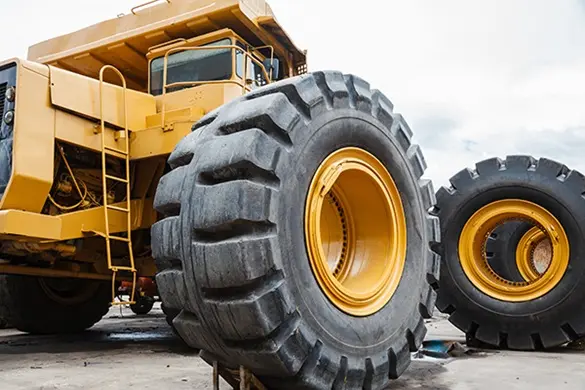Tyre Response Groups: Tips for Effective OTR Tyre Management
Managing Off-The-Road (OTR) tyres is a crucial task for fleet managers, heavy equipment operators, and maintenance personnel. Effective OTR tyre management can lead to extended tyre life, improved safety, and optimised performance.
Understanding OTR Tyre Management
OTR tyre management is a comprehensive approach aimed at maintaining and optimising the performance of Off-The-Road tyres. This process encompasses a range of activities, from regular inspections and maintenance to data tracking and analysis. The objective is to maximise the lifespan of the tyres, ensure safety, and enhance operational efficiency by preventing premature tyre wear, detecting issues early, and making informed decisions about tyre repair or replacement.
Key Aspects of Effective OTR Tyre Management:
- Regular tyre inspections: checking for cuts, bulges, and abnormal wear.
- Tyre pressure monitoring: maintaining the correct pressure to extend tyre life and ensure safety.
- Load distribution: Understanding its impact on tyre wear and performance.
- Tyre rotation: Promoting even wear and extending tyre life.
- Tyre selection: choosing the correct tyre for the application and terrain.
- Tyre temperature management: preventing overheating and damage during operation.
- Record keeping: tracking tyre performance and planning maintenance.
- Tyre repair and retreading: assessing when a tyre is beyond repair and must be replaced.
- Tyre storage: preserving tyre quality and preventing damage.
- Training operators: encouraging tyre-friendly driving habits.
- Environmental considerations: understanding factors that can affect tyre longevity.
Mastering these aspects allows the creation of a robust OTR tyre management plan that yields tangible benefits for your operations.
The Importance of Regular Tyre Inspections
Regular tyre inspections form the cornerstone of effective OTR tyre management, helping to identify potential issues before they escalate into major problems.
During an inspection, look for cuts, bulges, and abnormal wear, which can indicate underlying issues potentially compromising tyre performance and safety. For instance, cuts or bulges may suggest structural damage, which could lead to tyre failure during operation, posing safety risks and causing costly downtime. Abnormal wear, on the other hand, could indicate problems with tyre pressure, alignment, or load distribution. Addressing these issues promptly extends the tyre’s lifespan and improves its performance.
Proper Tyre Pressure: A Key to Longevity and Safety
Maintaining the correct tyre pressure is vital for the longevity and safety of OTR tyres. Tyre pressure affects the tyre’s contact with the ground, influencing wear patterns and fuel efficiency.
Underinflated tyres can cause excessive heat build-up and internal structural damage, leading to premature tyre failure, safety risks, and unnecessary downtime. Conversely, overinflated tyres can lead to uneven wear and reduced traction, compromising vehicle stability and performance, especially in off-road conditions.
To ensure optimal tyre pressure, consider using a Tyre Pressure Monitoring System (TPMS), which provides real-time pressure readings, helping maintain the correct pressure and extend the tyre’s lifespan. Proper tyre pressure management is a simple yet effective strategy for enhancing OTR tyre safety and performance.

Load Distribution and Its Impact on Tyre Wear
Load distribution plays a significant role in OTR tyre management, directly impacting the wear and tear of the tyres and, consequently, their lifespan and performance.
An uneven load can lead to irregular wear patterns, resulting in premature tyre failure, increased maintenance costs, and potential safety risks. Regularly checking and adjusting the load on each tyre is crucial, as this practice can significantly extend the life of your OTR tyres and enhance overall operational efficiency.
Tyre Rotation Practices for Even Wear
Tyre rotation is a key aspect of OTR tyre management, helping promote even wear across all tyres, extending their lifespan, and improving performance.
The rotation pattern should be determined based on the vehicle type and its usage. Regular rotation can help identify potential issues early, preventing unexpected downtime. Incorporating tyre rotation into your regular maintenance schedule is a cost-effective strategy that can significantly reduce the need for premature tyre replacements, leading to substantial cost savings in the long run.
Selecting the Correct Tyre for Your Application
Choosing the correct tyre for your specific application is crucial in OTR tyre management. The tyre type should match the terrain and the load it will carry.
Different tyres are designed for different surfaces — some are ideal for rocky terrains, while others are better suited for sandy or muddy conditions. Selecting the correct tyre not only enhances performance but also extends tyre life, reducing the risk of premature wear and tear, thereby contributing to cost savings and operational efficiency.
Managing Tyre Temperature During Operations
Tyre temperature management is critical in OTR tyre management, as overheating can lead to tyre failure, pose safety risks and cause downtime.
Monitoring tyre temperature during operations helps prevent overheating, achieved through regular checks and advanced tyre temperature monitoring systems. Effective tyre temperature management prevents damage, extends tyre life, and ensures optimal performance, contributing to cost savings and improved operational efficiency.
Keeping Detailed Tyre Records for Performance Tracking
Maintaining detailed records of each tyre’s performance is a crucial part of effective OTR Tyre Management. These records should include information on tyre pressure, tread depth, rotation schedule, and any repairs or retreading.
These records provide valuable insights into each tyre’s performance and lifespan, helping to identify wear patterns, predict when a tyre might need replacement, and plan maintenance schedules effectively. Maintaining comprehensive tyre records allows informed decisions about tyre management, leading to improved performance, extended tyre life, and significant cost savings.
Assessing Tyre Repair and Replacement
Knowing when to repair or replace a tyre is a critical aspect of OTR tyre management. Regular inspections can help identify damage early, allowing for timely repairs. However, not all damage can be repaired — severe cuts, bulges, or abnormal wear may render a tyre beyond repair, necessitating replacement. Making the correct decision between repair and replacement can prevent unnecessary expenses and potential safety risks. It requires careful assessment and sound judgement.
The Benefits of Retreading Tyres
Retreading involves giving worn tyres a new life by replacing the worn tread with a new one. It is a cost-effective strategy that can significantly extend the life of OTR tyres. Additionally, retreading is an environmentally friendly practice, reducing the need for new tyres and thus saving resources and reducing waste. However, not all tyres are suitable for retreading. It is important to assess the condition of the tyre and ensure it is structurally sound before proceeding with retreading.
Effective OTR Tyre Management Guidelines for Proper Tyre Storage
Proper storage of OTR tyres is crucial for maintaining their quality. Tyres should be stored in a cool, dry place away from direct sunlight, as exposure to heat and UV rays can cause the rubber to degrade. It is also important to store tyres in an upright position to prevent deformation and stress on the tyre structure. Additionally, tyres should be kept away from chemicals or substances that can cause damage, such as oils, solvents, and corrosive materials. Proper storage can significantly extend the life of your OTR tyres.
Training Operators for Tyre-Friendly Driving
Operator habits can significantly impact tyre wear, making it essential to train operators for tyre-friendly driving. This training includes avoiding sudden starts and stops, which can cause excessive tyre wear, and avoiding sharp turns at high speeds, which can cause unnecessary stress on the tyres. Furthermore, operators should be aware of the terrain they are driving on and avoid driving over sharp objects or rough surfaces that can damage the tyres. Proper training enables operators to help extend the life of your OTR tyres.
Environmental Factors Affecting Tyre Longevity
Environmental factors can significantly impact the longevity of OTR tyres. Exposure to extreme temperatures can cause the rubber to harden or become brittle, leading to cracks and other damage. Chemicals, oils, and other substances can also degrade the rubber, making it important to clean tyres regularly and check for any signs of chemical damage. UV radiation from the sun can cause tyres to age prematurely. If possible, store your equipment in a shaded area when not in use to protect your tyres from harmful UV rays and extend their lifespan.
Creating a Comprehensive OTR Tyre Management Plan
A comprehensive OTR tyre management plan is essential for maximising ROI. It involves regular inspections, maintenance, and record-keeping to track tyre performance and plan for replacements.
The plan should also include training for operators to ensure they understand the impact of their driving habits on tyre wear and can operate the equipment in a tyre-friendly manner. Additionally, the plan should consider environmental factors and storage conditions. Proper storage can prevent damage and extend tyre life, while understanding environmental impacts enables preventive measures. Lastly, the plan should include strategies for emergency response in case of tyre failure to ensure safety and minimise downtime, further contributing to operational efficiency and cost savings.
Conclusion: Maximising ROI with Effective OTR Tyre Management
Effective OTR tyre management is not solely about extending tyre life but also about ensuring safety, optimising performance, and ultimately maximising ROI. By implementing regular inspections, proper maintenance, and a comprehensive tyre management plan, you can significantly reduce costs, including savings from reduced downtime, fewer tyre replacements, and improved fuel efficiency.
In conclusion, OTR tyre management is a critical aspect of fleet management that requires a proactive approach. The benefits, in terms of cost savings, safety, and operational efficiency, are well worth the effort.
For more information about Effective OTR Tyre Management, visit our blog






